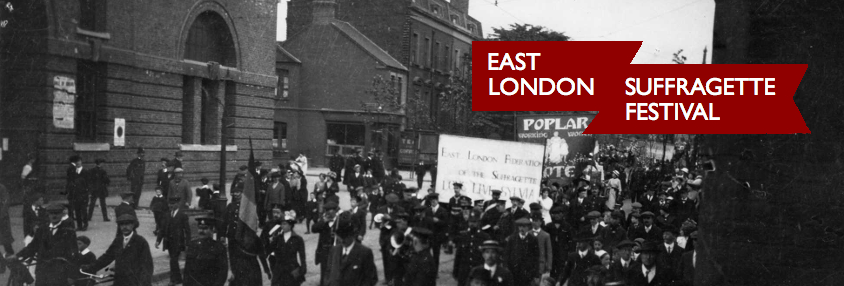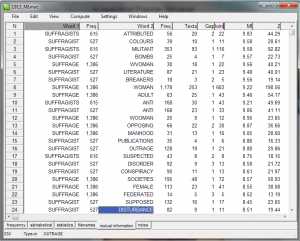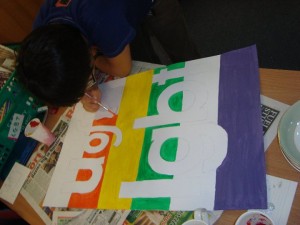I’ve been thinking a lot about erotica recently.
Basically, Alon Lischinsky handed me 1.4 billion words of online erotica, and I am helpless to resist a big corpus. I presented some preliminary finding at Corpus Linguistics 2017 (slides available at this link; more stuff available on the project page) in which we try to see how different genres of erotica in our corpus relate to each other.
We’re interested in a few angles: there is a lot of work on the historical aspects of porn (for example, how it has been produced and disseminated, the development of genres, its the cultural context and so on), porn that is seen to be somehow transgressive (for example, a recent special issue of Porn Studies was devoted to gonzo porn) and lesbian, gay, bisexual and queer porn. As far as we’re aware – and we’d love to be corrected! – there isn’t a lot of material looking at really straightforward common-or-garden amateur erotica. The corpus is collected from a large, well-established online repository of erotica. We don’t have a huge amount of information on who is creating it as many people decline to state their gender and/or sexuality (and the information they do give may reflect an identity other than their offline identity), but “male” is the most frequent gender and “straight” is the most frequent sexuality associated with authors in the dataset.
Doing some kind of work with erotica is going to create a response. I think it’s hard not to have some kind of engagement with erotica (and porn, and the erotic more broadly) in the culture I live in, even if that response is to deliberately avoid it. There isn’t a lot of room for self-indulgent reflexivity in academic texts but, happily, a blog is all about self-indulgence and as these thoughts have been swirling around in my head and cluttering up my mental space, I thought I’d try to write about them here.
The first thing I’ve been thinking about is my own experience with erotica.
Baby queer
I grew up in a religious environment and went to a single-sex Catholic school in the 1990s (that bit is important). We did recieve some sex ed in Year 7 – it vacilliated between the strictly biological (calculating ovulation dates and some “insert Tab A into Slot B” style diagrams) and “cut out pictures of families from magazines and stick them to a bit of A3 paper” – said couples were all heterosexual and monogamous, what a surprise. At no point were we taught that sex was not simply biological and not performed solely for reproductive purposes; there was some discussion of the rhythm method but absolutely nothing about contraception. At an adult, it grieves me how badly we were failed by this “education”. It meant that we tried to seek out information from other sources, chiefly Just 17 and More! magazines – and ended up learning a lot of sexist crap about gendered relationships as well as what a condom was.
Predictably, as teenagers, we rebelled. We smuggled in copies of women’s magazines and read the sex advice with avid curiosity, devouring information both about birth control and how to please your man and 10 sexy tricks he’ll never forget. In sixth form, we had a section of a noticeboard in our common room devoted to condom receipts and, at Christmas time, someone pinned up photos of naked men wearing strategically placed Santa hats. The local nickname for pupils included the word “sluts” and there was a persistant rumour that while our school had the higher conception rate, the other all-girls school had the higher birth rate. As far as I know, no evidence was ever produced to substantiate this claim but nevertheless, it refused to die.
For me, it was complicated by the fact I was not heterosexual or, it turned out, cisgender. A single-sex Catholic school under Section 28 was not a kind or nurturing or, indeed, safe for a young queer. Section 28 made it illegal for the school to promote homosexual relationships and being a Catholic school, they weren’t going to anyway. I initially thought I was asexual because I was aggressively uninterested in the heterosexualities on offer: either reproduction in the context of the nuclear heterosexual family or a lot of what seemed like fairly unpleasant recreational sex with unpleasant, pushy men. I noped out of that pretty quickly and at one point, my plan was to become a monk and, I don’t know, look after bees.
Queer lessons from fic
However, the queers and weirdos and outsiders also found Stuff To Read About Sex, and our salvation came in the form of fanfiction.net. There was a thriving exchange of fic, printed out over a very rationed dial-up connection and hidden in A4 ringbinders amoungst the Biology notes and English annotated poems. I found this much more interesting, especially when I hit upon a rich seam of genderfuck Placebo fic which I proceeded to mine for weeks. It was a secret rebellion – literally underground because our common room was in a basement which we made a bold attempt to tunnel out of.
In a way, fanfiction educated me. It taught me that there were sexualities other than heterosexual ones, and genders that didn’t easily map onto “man” and “woman”, and people could (in theory at least) have genders were fluid and shifted between these, and people (again, in theory) were attracted to them and wanted to have sex with them. It spoke of people who loved people of their gender, people who accepted their lover in whatever gender they presented, people who negotiated sex and boundaries and consent, people who didn’t have happily-ever-afters but who had to talk and argue and reconfigure their friendship and relationship. The screen did not coyly fade to black and the story often did not end with sex; instead, there were morning-afters and misunderstandings and confusion that had to be resolved. The people had agency and were active participants, and sex did not fundamentally change them. Fic gave me some words to start describing who I loved and who I was, and although they weren’t necessarily the right words and sat uneasily on me, they felt a lot better than “straight” or “heterosexual”.
It wasn’t perfect – while I commend whoever thought up of the lube spell for having the awareness that yes, lube is generally a good idea for anal sex, I could quite happily go without reading about it again – but it was a different discourse, one that pitted itself against that I learnt in school and that I learnt through women’s magazines, and it was a quiet and hopeful voice that said, “this is not the way things have to be; create something better”.
I am not good at writing these stories, but I like to think that that message stayed with me. It led me across gender identities and sexualities, into places where no labels exist, into places where things collide in interesting and apparently impossible ways. These stories could express things I didn’t know I wanted, didn’t know existed. There’s something really hopeful about that.
Sex educator
In my teens and early twenties I made Quite A Lot of bad relationship decisions (turns out having very little concept of boundaries or consent is not exactly great for happy, loving, supportive relationships!) and eventually staggered my way into coming out and, eventually, made much better relationship decisions. Along the way I realised that I did not know nearly enough about sex as I should and researched the hell out of it to the extent that, as an LGBT Welfare Officer, I could plan and give workshops on sexual health. I spent a lot of time with queer activists who were doing a lot of talking and thinking about things like boundaries, negotiation and consent: what they meant, what they looked like in practice, how to model them in our friendships and relationships (not written by someone I know, but this is indicative of the conversations we were having). I went into weird, deep internet dives about all sorts of things.
I ended up reading detailed posts about lube (lots of posts about lube!), toxic sex toys, the campaign for non-toxic sex toys, descriptions of vibrations and comics about sex toys and sex, identities, fantasy and relationships. I learnt about Safe, Sane and Consensual and RACK (Risk-Aware Consensual Kink) and the differences between them – basically, that some activities will never be totally safe but there’s a lot you can do to mitigate that risk. I learnt about safewords and what negotiating a scene might look like. I learnt about different models of relationships and different dynamics within relationships. I learnt how to approach, learn about and not judge what kinds of sex people were having, even if it was not something I was into myself.
I also learnt and thought a lot about negotiating consent and how I could apply what I’d learnt to non-sexual contexts. I think a lot about what it looks like when I teach challenging material or when I interact with my parrot companion. I want to be having conversations in which “no” is something that can be said knowing it will be respected, making a “yes” more meaningful.
As such, I find it quite difficult to read some of the erotica texts in the corpus. If I read them with a sex educator hat on, there’s a lot to side-eye. A lot of acts are simply anatomically impossible and/or certainly anatomically inadvisable. Some of the stuff about anal sex is pretty hair-raising (ramming it in and hoping for the best is probably not a good idea! neither is switching from anal to vaginal sex without changing condom!), the pill is not a barrier method and pretty much everyone is in need of more lube. However, as I’ll discuss in the next section, that’s not necessarily how the texts are meant to be read.
A lot of these texts are written by people who identify themselves as heterosexual (cis) men, who aren’t a group I’m generally attracted to and with whom (with notable exceptions!) I don’t interact much outside family and colleagues. I find them pretty baffling. There is material in this corpus that I find troubling about women, trans people, Black and minority ethnic people, about relationships and sex between women and men. As someone who has been racially fetishised before and for whom it is a hard “no”, it’s difficult to be confronted with that and to remain detached.
Erotic complexities
However, it’s also important to think about the complexities of online erotica. In critical discourse analysis, we are trained to think about texts as representing and creating a reality. For example, whether I talk about a group of people as “activists” or “protesters” or “a mob” or “rioters” matters: I might be talking about the same people doing the same things, but how I conceptualise them and communicate my conceptualisation of them is important. How I write about them creates and sustains my worldview, and I can persuade people to share my way of looking at things and interpreting events.
It is important to understand that erotica does not have a simple relationship with reality. The world constructed in an erotica text is a world that does not necessarily map onto real-world desires, but, at the same time, it does reflect the cultural context in which it is produced. Alon has explored agency roles in a subset of the erotica corpus and found that male characters are presented as active participants while female participants are presented as passive. This cannot be read in isolation, and we have to think about how it reflects a sexist power dynamic and heterosexist assumptions of the roles women and men have in sex.
There are straightforwardly fantastical elements in these texts. While establishing the ontological reality of vampires, werewolves and aliens is beyond the scope of this project, if people were having sex with vampires, werewolves and/or aliens as often in real life as they are in this corpus, I think there would be much fewer trashy documentaries speculating about their existence (n.b. I love these trashy documentaries, don’t judge).
However, there are also things happening in these texts that are more complicated. As an example, authors create a persona when they upload their stories. It’s impossible (within the constraints of our dataset) to work out to what extent these map onto their offline identities. I use the term “offline” rather than “real” because these identities can be very real; for example, someone may be able to explore a sexual identity through erotica long before they’re ready to come out (if they decide to come out at all). The writing identity itself may be erotically charged and someone might find it arousing to inhabit a different identity when writing or reading erotica.
People imagine sexual activities that they would not neccesarily find erotic or desirable if they happened in reality. These may be experiences or dynamics; for example, scenes of humiliation, kidnap and/or forced sex. This is not unique to erotica; people in the BDSM have written about staging sex by force fantasies (link NSFW, CN for rape and sexual assault) in a consensual way, so the desirable, erotically charged elements that make it appealing can be experienced.
People also write physical acts, such as types of genital stimulation, that they have either not experienced or would actively not like to experience in reality but in the world of the text it becomes something desirable. Sometimes people write about physical acts in a way that doesn’t reflect real life. There are extremely ambitious refractory periods, anal sex without any kind of warm-up or preparation, sex without a barrier method, insufficient lube, and lots and lots of unnegotiated sex and assumptions about the kind of sex the participants are going to have. On one hand, this is fine in the world of text – in the text world that is being created, these things may have an internal logic.
However, this again has a complex relationship with reality. As I discussed earlier, sometimes erotica is someone’s first encounter with sexual acts or types of sexuality – that was certainly true for me. I think there are different issues here: what does it mean to depict unrealistic sex if readers understand that this takes place in a text world where the rules (of anatomy, of behaviour, of consent, of sex) are different versus what does it mean to depict unrealistic sex if readers are not aware that there is this distance between the text world and the real world? There are interesting conversations to be had about the presence of erotica, and porn more generally, in people’s lives and how it informs their sexualities.
Conclusion
Erotica gives me a lot to think about, and often forces me to challenge my ways of thinking. The erotic texts in this corpus offer different challenges than what I’m used to – they’re very much not coming from my queer feminist consent-aware bubble, and contain material that is distressing and difficult. However, I think it’s important to investigate texts like these: through examining fantasies, I hope that we can discover something about how people write about and think about and imagine sex and sexuality.





